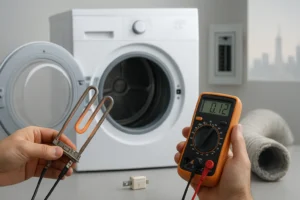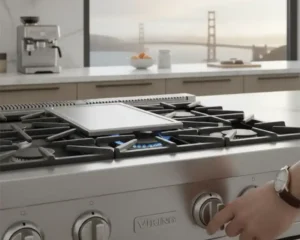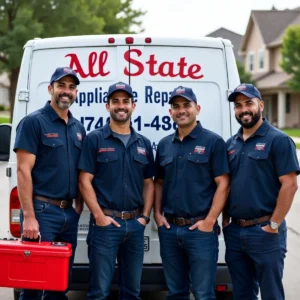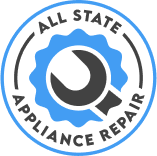Refrigerator Not Cooling? Here’s What You Need to Know!
Nothing’s more frustrating than opening your refrigerator to find warm food and drinks. If your refrigerator isn’t cooling properly, don’t panic! This common problem can occur for various reasons, from simple thermostat issues to blocked vents or faulty components.
In this comprehensive guide, we’ll walk you through 7 common causes of a fridge not cooling and provide practical troubleshooting tips to help you fix the issue.
7 Common Causes of Refrigerator Not Cooling
Dirty Condenser Coils: These coils release heat as the refrigerant flows through them. When covered in dust and debris, they can’t effectively dissipate heat, hindering the cooling process.
Blocked Air Vents: Cold air circulates within the refrigerator through vents. Suppose food items block these vents. In that case, restricted airflow causes uneven cooling or a lack of cooling.
Faulty Door Seals (Gaskets): The rubber seals around the refrigerator doors maintain a tight seal, preventing warm air from entering. Damaged or dirty gaskets allow warm air to leak, forcing the refrigerator to work harder and potentially failing to maintain a cool temperature.
Incorrect Thermostat Setting: A simple oversight could be an incorrectly set thermostat. Please set it to the desired temperature and avoid accidentally turning it off or setting it too high.
Faulty Evaporator Fan: The evaporator fan circulates air over the evaporator coils, which cools the air. If the fan motor is defective, it won’t circulate the cool air, leading to a lack of cooling.
Malfunctioning Compressor: The compressor, the heart of the refrigeration system, circulates refrigerant to maintain cooling. A faulty compressor can cause inconsistent cooling, strange noises (humming or clicking), or complete cooling failure. Common causes include electrical issues, worn components, or insufficient lubrication.
Refrigerant Leak: Refrigerant is the cooling agent in the refrigerator. A leak in the refrigerant lines reduces the amount of refrigerant, directly affecting the cooling capacity. This issue often requires professional repair.
Steps to Fix Refrigerator Cooling Problems
1. Clean the Dirty Condenser Coils
Instructions:
- Unplug the refrigerator to ensure safety.
- Locate the condenser coils (usually at the back or bottom of the fridge).
- Use a coil brush or vacuum cleaner with a hose attachment to remove dust and debris carefully.
- Ensure the area around the coils is clean and free of obstructions for proper airflow.
- Plug the refrigerator back in and check for improved cooling.
Safety Precautions:
- Always unplug the appliance before cleaning the coils to avoid electrical shock.
- Wear gloves to protect your hands from sharp components.
- Be cautious when moving the refrigerator to prevent damage to the flooring or the appliance.
Learn more: How to Clean Refrigerator Condenser Coils
2. Unblock Air Vents
Instructions:
- Open the refrigerator and freezer compartments.
- Check for food items, containers, or packaging blocking the vents.
- Rearrange the contents to allow unrestricted airflow.
- Avoid overloading the refrigerator to ensure proper circulation of cold air.
Safety Precautions:
- Be mindful of heavy or slippery items while rearranging contents.
- Keep vents clear regularly to prevent future cooling issues.
3. Check and Replace Faulty Door Seals
Instructions:
- Inspect the door seals (gaskets) for cracks, tears, or dirt buildup.
- Clean dirty gaskets using warm, soapy water and a soft cloth.
- If the seals are damaged, purchase replacements specific to your refrigerator model.
- Remove the old seals by pulling them off gently, and install new ones by pressing them into place.
Safety Precautions:
- Ensure the refrigerator is off while replacing the gaskets to prevent injury.
- Handle the seals carefully to avoid tearing or damaging new gaskets during installation.
4. Adjust the Thermostat Setting
Instructions:
- Check the thermostat setting inside the refrigerator.
- Please set it to the manufacturer-recommended temperature. (typically 37°F for the refrigerator and 0°F for the freezer).
- If the dial is loose or unresponsive, it may need replacement.
Safety Precautions:
- Unless you have proper training, avoid tampering with the electrical components of the thermostat.
- If the thermostat needs replacement, unplug the refrigerator before proceeding.
5. Inspect and Replace the Faulty Evaporator Fan
Instructions:
- Unplug the refrigerator.
- Remove the freezer panel to access the evaporator fan.
- Check whether anything obstructs the fan blades or the motor has a fault.
- If necessary, replace the fan motor by disconnecting the wires and attaching a new one.
- Reassemble the freezer panel and plug the refrigerator back in.
Safety Precautions:
- Always unplug the appliance before inspecting or replacing the fan.
- Wear safety gloves to avoid cuts from sharp edges.
- Ensure the replacement part matches your refrigerator model.
6. Address Compressor Issues
Instructions:
- Unplug the refrigerator and move it away from the wall.
- Inspect the compressor (usually located at the back near the bottom) for signs of damage or overheating.
- Contact a professional technician if you hear unusual noises or notice it’s not running.
- Regular maintenance can prevent compressor failure in the future.
Safety Precautions:
- Please do not attempt to open or repair the compressor yourself, as it contains hazardous components.
- Ensure the refrigerator is unplugged while inspecting the compressor.
- Avoid prolonged contact with the compressor, as it may be hot.
7. Fix Refrigerant Leak
Instructions:
- Look for signs of a refrigerant leak, such as an oily residue near the coils or compressor.
- If you suspect a leak, do not attempt to fix it yourself.
- Contact a certified technician to repair the leak and recharge the refrigerant.
Safety Precautions:
- Refrigerants are hazardous and can cause health issues if mishandled.
- Always leave refrigerant-related repairs to licensed professionals.
- Ensure proper ventilation in the area while waiting for professional assistance.
Preventive Measures to Avoid Refrigerator Cooling Problems
Preventive maintenance is key to running your refrigerator smoothly and avoiding costly repairs. By following a few simple steps, you can prevent standard refrigerator cooling problems and ensure optimal performance:
- Regularly Clean Condenser Coils: Over time, dust and debris can accumulate on the condenser coils, making it harder for the refrigerator to release heat. This buildup forces the unit to work harder, reducing its cooling efficiency. Cleaning the coils every 6 to 12 months helps maintain proper cooling and prolongs the appliance’s lifespan.
- Ensure Proper Airflow Inside the Fridge: Proper airflow is essential for consistent cooling throughout the refrigerator. Avoid blocking air vents with large food items, and keep the interior organized to allow air to circulate freely. Ensuring good airflow helps prevent uneven cooling and potential food spoilage.
- Check and Maintain Door Seals: Door seals (gaskets) play a vital role in maintaining the internal temperature by preventing warm air from entering the refrigerator. Regularly inspect the seals for cracks or dirt buildup and clean them as needed. Replacing worn-out seals will help the refrigerator maintain a consistent cool temperature.
- Avoid Overloading the Refrigerator: Overloading the refrigerator can restrict airflow and hinder its ability to cool effectively. Keep the fridge well-organized and avoid placing too many items close together. A reasonable load ensures the appliance operates efficiently without overworking the cooling system.
By incorporating these preventive maintenance practices into your routine, you can reduce the risk of refrigerator cooling problems and enjoy a consistently well-performing appliance for years.
When to Call an Expert for Refrigerator Repair
You can resolve many refrigerator cooling problems with DIY fixes, but some need professional attention. If you notice any of the following signs, it’s best to call an expert:
- Persistent Cooling Problems: Suppose your refrigerator continues to struggle with cooling despite trying standard troubleshooting methods. In that case, an underlying issue may need professional diagnosis and repair.
- Unusual Noises or Overheating: Loud humming, buzzing, or clicking noises and excessive heat from the back of the refrigerator often indicate serious problems with the compressor or fan motor. A qualified technician should address these issues to prevent further damage.
- Frequent Breakdowns: Constant breakdowns or recurring problems disrupt your daily life and increase energy consumption and repair costs. A professional can inspect the unit thoroughly and recommend the most effective solution.
If you’re dealing with any of these signs and DIY solutions aren’t working, it’s time to consider scheduling a professional refrigerator repair. Our experienced technicians provide reliable fridge and appliance repair services to ensure your refrigerator operates efficiently. Learn more about our refrigerator repair service and quickly get your appliance back to peak performance!
Final thoughts
Keeping your refrigerator in top condition is essential to avoid food spoilage and costly repairs. Regular maintenance, which includes cleaning the condenser coils, ensuring proper airflow, and checking the door seals, can help prevent many common refrigerator cooling problems. Addressing minor issues early through proper refrigerator troubleshooting can save you from more significant, more expensive problems down the line. However, suppose your refrigerator continues to struggle with cooling or shows persistent signs of malfunction. In that case, it’s best to seek professional help. A well-maintained refrigerator keeps your food fresh and operates more efficiently, ensuring you don’t have to wonder why your refrigerator is not cold again.
Key Takeaways
- Common Causes of Cooling Issues : Refrigerator cooling problems often stem from dirty condenser coils, blocked air vents, faulty door seals, incorrect thermostat settings, evaporator fan failure, compressor issues, or refrigerant leaks. Identifying the root cause is crucial for effective troubleshooting.
- DIY Fixes : Many refrigerator issues can be resolved with simple DIY solutions, such as cleaning condenser coils, unblocking air vents, adjusting the thermostat, and replacing worn-out door seals. Regular maintenance can prevent these problems from occurring.
- When to Call a Professional : Persistent cooling problems, unusual noises, overheating, or frequent breakdowns indicate the need for professional repair. Attempting to fix complex issues like refrigerant leaks or compressor failure yourself can be dangerous and should be left to certified technicians.
- Preventive Maintenance : To avoid cooling problems, regularly clean condenser coils (every 6–12 months), ensure proper airflow inside the fridge, inspect and maintain door seals, and avoid overloading the appliance. These steps help extend the refrigerator’s lifespan and maintain optimal performance.
- Cost vs. Repair : For minor issues like dirty coils or faulty seals, repairs are usually worth it. However, if the refrigerator is older and the problem involves major components like the compressor, replacement may be more cost-effective than repair.
By following these guidelines, you can keep your refrigerator running efficiently and avoid costly repairs or food spoilage.
Frequently Asked Questions (FAQs) Regarding Refrigerator Not Cooling
Q1: Why is my refrigerator not cooling but the freezer is working?
Ans: This is a common issue caused by blocked air vents, faulty evaporator fans, or a malfunctioning damper that prevents cold air from circulating from the freezer to the fridge compartment.
Q2: How do I troubleshoot a refrigerator that’s not cooling?
Ans: Start by checking thermostat settings, cleaning the condenser coils, ensuring proper airflow, inspecting door seals, and unblocking air vents. If the problem persists, consider calling a professional.
Q3: What are the common causes of a refrigerator not cooling properly?
Ans: Common causes include dirty condenser coils, faulty door seals, blocked air vents, incorrect thermostat settings, evaporator fan failure, compressor issues, and refrigerant leaks.
Q4: Can dirty condenser coils cause a refrigerator to stop cooling?
Ans: Yes, dirty condenser coils reduce heat dissipation, causing the refrigerator to overwork and lose cooling efficiency. Cleaning the coils regularly can prevent this issue.
Q5: How can I tell if my refrigerator compressor is bad?
Ans: Signs of a bad compressor include loud humming or clicking noises, the refrigerator not cooling at all, and the compressor not running despite proper power supply.
Q6: What should I do if my fridge has a refrigerant leak?
Ans: If you suspect a refrigerant leak, do not attempt to fix it yourself. Contact a certified technician for proper repair and refrigerant recharging.
Q7: How often should I clean the refrigerator’s condenser coils?
Ans: Cleaning the condenser coils every 6 to 12 months is recommended to maintain optimal cooling performance and prevent overheating.
Q8: Is it worth repairing a refrigerator that’s not cooling?
Ans: It depends on the age of the refrigerator and the severity of the issue. If the problem involves minor fixes like cleaning coils or replacing seals, repair is usually worth it. For major issues like compressor failure in older models, replacement might be a better option.
Q9: How do I know when to call a professional for refrigerator repair?
Call a professional if your refrigerator experiences persistent cooling problems despite troubleshooting, produces unusual noises, overheats, or frequently breaks down.
Q10: What preventive maintenance can I do to avoid refrigerator cooling problems?
Ans: Preventive steps include cleaning condenser coils regularly, ensuring proper airflow inside the fridge, checking and maintaining door seals, and avoiding overloading the refrigerator.






